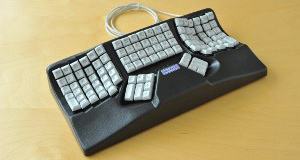What is the best hand position to prevent RSI?
A major cause of Repetitive Strain Injury (RSI) is the prolonged and repetitive hand movements involved in computer keyboard use. Given the amount of time spent by most people at their computer typing it is no wonder that RSI is an issue of great concern in the workplace. The Victorian WorkCover Chief Executive reported in recent years that soft tissue and muscle injuries such as RSI accounted for 62% of all WorkCover claims. See our earlier blog for more statistics regarding the prevalence of RSI.
The design of many keyboards tends to create or exacerbate the problem. Read on to find out about the best hand positions to prevent or help manage RSI, and what you need to do to ensure you minimise your chances of getting this painful and disabling condition.
Startling research about RSI and the benefits of Maltron Keyboards
 In the United Kingdom, where the Maltron keyboard originated over 25 years ago, much research has been undertaken on Repetitive Strain Injury (RSI) and the advantages of the Maltron keyboard in helping to prevent and manage this condition. Unfortunately similar research has not been conducted in Australia, but we hope in the future it will be. Particularly when the figures are so alarming and the benefits of Maltron keyboards so striking.
In the United Kingdom, where the Maltron keyboard originated over 25 years ago, much research has been undertaken on Repetitive Strain Injury (RSI) and the advantages of the Maltron keyboard in helping to prevent and manage this condition. Unfortunately similar research has not been conducted in Australia, but we hope in the future it will be. Particularly when the figures are so alarming and the benefits of Maltron keyboards so striking.
Read on to find out more..
Take action against RSI!
Strain injuries at work, the most common being Repetitive Strain Injury are caused by excessive force being imposed on muscles, tendons, joints and the nervous system by some working practices (such as typing). When the strain is of short duration accompanied by adequate rest it generally does not cause significant damage. However, with work practices being increasingly sedentary and with the overwhelming majority of jobs requiring long periods of keyboard use, this can result in very frequent exertions of forced static postures which can result in a loss of capacity in the affected limbs.
The three main factors that can lead to strain injuries include:
FORCE – the application of excessive manual force
FREQUENCY AND DURATION OF MOVEMENT – including rates of working which are intense and repetitive
AWKWARD OR RIGID POSTURE – particularly of hand, wrist, arm or shoulder
Book examines lack of functionality in design of QWERTY keyboard
 The Design of Everyday Things (formerly entitled The Psychology of Everyday Things) by Donald Norman discusses the issue of design and functionality of everyday objects and the frustration – and worse – that can arise when objects are ill-designed and not user-friendly.
The Design of Everyday Things (formerly entitled The Psychology of Everyday Things) by Donald Norman discusses the issue of design and functionality of everyday objects and the frustration – and worse – that can arise when objects are ill-designed and not user-friendly.
From taps and doors to computers and aeroplane cockpits, Norman (2002) provides examples of poorly designed objects and the impact on the user; ranging from mere annoyance to tragic injury and even death.
One of the products he discusses is the QWERTY (also known as Sholes) keyboard, the standard keyboard used with most computers. He outlines the deficiencies of the keyboard and its inappropriateness in the modern world, requiring faster keying speeds and designs that are comfortable for the hands and wrists.
Revolutionary Maltron keyboard helps prevent Repetitive Strain Injury
What is RSI?
Repetitive Strain Injury (RSI) (also known as repetitive stress injury, occupational overuse syndrome and regional musculoskeletal disorder) is an injury of the musculoskeletal and nervous system caused by prolonged repetitive hand movements or sustained or awkward positions, such as those involved in computer, mouse and keyboard use.

Recent Comments